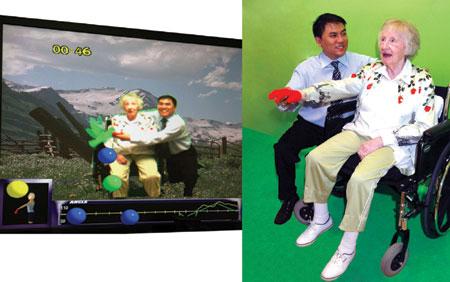ORTHOPEDICS TODAY
By Gina Brockenbrough
Oct 29 2009
"Beth Abraham Hospital has been so impressed with GestureTek’s Interactive Virtual Rehabilitation & Exercise System (IREX) that they have purchased four units over the past few years". Vincent John Vincent, President, GestureTek.
Some health care facilities are using virtual rehabilitation systems in conjunction with traditional modes of rehabilitation to help patients regain function.
Using the systems can help patients simultaneously improve balance, coordination, muscle strength and range of motion, while providing quantitative data for physical therapists.
“We put the patient in a computer-generated world that allows for isolated or combined joint movement or even full-bodied functional movements,” Randy Palmaira, corporate director of rehabilitation for Beth Abraham Family of Health Services, told Orthopedics Today. “The system also compiles data based on these movements for the therapist.” His center is the first health care facility in New York City to offer virtual rehabilitation.
Cognitive, functional skills
The facility uses the Interactive Rehabilitation and Exercise System (IREX, GestureTek Health) which features several different clinician-selected programs, such as soccer, snowboarding and laundry-sorting games, which target specific muscle groups. The system also uses gesture-sensing technology to measure patients’ movements.
Unlike traditional rehabilitation where the therapist must interrupt patients’ movements to take goniometric measurements, the virtual system incorporates a virtual goniometer that is displayed on-screen. Programs can be set for a bell to ring when patients have reached a specific functional target, such as 90° of knee flexion. The system also has a deflection mode which determines the amount of force a patient is exerting. In addition, a report is printed at the end of each session detailing the patient’s accuracy during the program.
While virtual reality entertainment systems display animated characters on-screen in the place of the patient, Palmaira noted that the IREX system projects a real-time camera image of the patient. Programs that require patients to sort items, such as colored and white laundry, also focus on executive functioning.
“It is something that is cognitive, functional and physical rolled into one and that makes it different,” Palmaira said.
Indications
He noted that virtual rehabilitation systems can be beneficial for patients who have neurological impairment, have undergone an amputation or have had any surgical procedure that resulted in weight-bearing restrictions, such as fractures and total hip and knee replacements.
Virtual rehabilitation systems similar to the IREX cost between $10,000and $16,000, Palmaira said. The number of necessary therapy sessions varies on an individual basis.
“Oftentimes, what we observe is that after three sessions, the patients will improve their balance,” Palmaira said.
During sessions, it is crucial that therapists explain to patients how the movements used during a simulated game, such as leaning forward and weight shifting, can be used transferred to daily functional tasks like ambulation and balance.
“The transfer of knowledge and the transfer of function are faster for the patient to see and understand,” Palmaira said.
Benefits for therapists, patients
“It is a comprehensive, clinician-controlled exercise system,”Palmaira said. He noted that the system allows the therapist to control the region of the body that will be targeted during the simulation, whether the frontal or sagittal plane is engaged. The therapist is able to increase or decrease the level of intensity based on the patient’s capabilities.
“It is fun for the patients,” Palmaira said. “It promotes greater compliance and increases the therapeutic output.”
He also noted that because the system does not have an external device, like a remote control, it does not support cross-contamination between patients.
“Virtual rehabilitation encourages patients to use their bodyweight to perform closed kinematic exercises, as opposed to open kinematic exercises that require external resistive devices, such as dumbbells,”Palmaira said. “As a result, it is safer and the transfer of movement to afunctional task is faster and more enhanced than with traditional therapy.”








